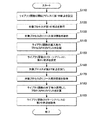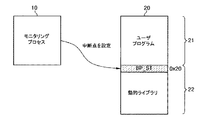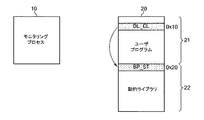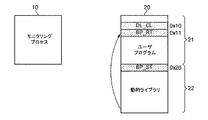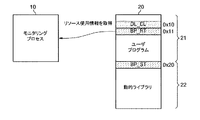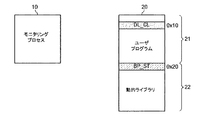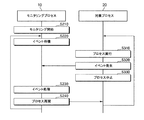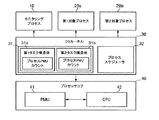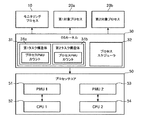JP2014106972A - Profiling method for dynamic library - Google Patents
Profiling method for dynamic library Download PDFInfo
- Publication number
- JP2014106972A JP2014106972A JP2013237693A JP2013237693A JP2014106972A JP 2014106972 A JP2014106972 A JP 2014106972A JP 2013237693 A JP2013237693 A JP 2013237693A JP 2013237693 A JP2013237693 A JP 2013237693A JP 2014106972 A JP2014106972 A JP 2014106972A
- Authority
- JP
- Japan
- Prior art keywords
- pmu
- count value
- target process
- event
- dynamic library
- Prior art date
- Legal status (The legal status is an assumption and is not a legal conclusion. Google has not performed a legal analysis and makes no representation as to the accuracy of the status listed.)
- Pending
Links
Images
Classifications
-
- G—PHYSICS
- G06—COMPUTING; CALCULATING OR COUNTING
- G06F—ELECTRIC DIGITAL DATA PROCESSING
- G06F9/00—Arrangements for program control, e.g. control units
- G06F9/06—Arrangements for program control, e.g. control units using stored programs, i.e. using an internal store of processing equipment to receive or retain programs
- G06F9/46—Multiprogramming arrangements
-
- G—PHYSICS
- G06—COMPUTING; CALCULATING OR COUNTING
- G06F—ELECTRIC DIGITAL DATA PROCESSING
- G06F11/00—Error detection; Error correction; Monitoring
- G06F11/30—Monitoring
- G06F11/34—Recording or statistical evaluation of computer activity, e.g. of down time, of input/output operation ; Recording or statistical evaluation of user activity, e.g. usability assessment
- G06F11/3466—Performance evaluation by tracing or monitoring
-
- G—PHYSICS
- G06—COMPUTING; CALCULATING OR COUNTING
- G06F—ELECTRIC DIGITAL DATA PROCESSING
- G06F9/00—Arrangements for program control, e.g. control units
- G06F9/06—Arrangements for program control, e.g. control units using stored programs, i.e. using an internal store of processing equipment to receive or retain programs
-
- G—PHYSICS
- G06—COMPUTING; CALCULATING OR COUNTING
- G06F—ELECTRIC DIGITAL DATA PROCESSING
- G06F11/00—Error detection; Error correction; Monitoring
- G06F11/30—Monitoring
- G06F11/34—Recording or statistical evaluation of computer activity, e.g. of down time, of input/output operation ; Recording or statistical evaluation of user activity, e.g. usability assessment
- G06F11/3409—Recording or statistical evaluation of computer activity, e.g. of down time, of input/output operation ; Recording or statistical evaluation of user activity, e.g. usability assessment for performance assessment
-
- G—PHYSICS
- G06—COMPUTING; CALCULATING OR COUNTING
- G06F—ELECTRIC DIGITAL DATA PROCESSING
- G06F11/00—Error detection; Error correction; Monitoring
- G06F11/30—Monitoring
- G06F11/34—Recording or statistical evaluation of computer activity, e.g. of down time, of input/output operation ; Recording or statistical evaluation of user activity, e.g. usability assessment
- G06F11/3466—Performance evaluation by tracing or monitoring
- G06F11/348—Circuit details, i.e. tracer hardware
-
- G—PHYSICS
- G06—COMPUTING; CALCULATING OR COUNTING
- G06F—ELECTRIC DIGITAL DATA PROCESSING
- G06F2201/00—Indexing scheme relating to error detection, to error correction, and to monitoring
- G06F2201/86—Event-based monitoring
-
- G—PHYSICS
- G06—COMPUTING; CALCULATING OR COUNTING
- G06F—ELECTRIC DIGITAL DATA PROCESSING
- G06F2201/00—Indexing scheme relating to error detection, to error correction, and to monitoring
- G06F2201/88—Monitoring involving counting
Landscapes
- Engineering & Computer Science (AREA)
- Theoretical Computer Science (AREA)
- General Engineering & Computer Science (AREA)
- Physics & Mathematics (AREA)
- General Physics & Mathematics (AREA)
- Software Systems (AREA)
- Computer Hardware Design (AREA)
- Quality & Reliability (AREA)
- Debugging And Monitoring (AREA)
Abstract
Description
本発明は、動的ライブラリのプロファイリング方法に関するものである。 The present invention relates to a dynamic library profiling method.
プロファイリングとは、実行中のプログラムの実行モードやOS(operating system)カーネルとの通信モードなどを解析することをいう。プロファイリングによりプログラムの性能情報を測定し、プログラムの実行において性能低下の要因などを見いだすことができる。 Profiling refers to analyzing the execution mode of a program being executed, the communication mode with an OS (operating system) kernel, and the like. By measuring the performance information of the program by profiling, it is possible to find out the factors of performance degradation in the execution of the program.
本発明が解決しようとする課題は、動的ライブラリ関数単位のPMUイベントカウントを測定できる動的ライブラリのプロファイリング方法、これを記録したコンピュータ読み取り可能な記録媒体及び動的ライブラリのプロファイリングシステムを提供することにある。 A problem to be solved by the present invention is to provide a dynamic library profiling method capable of measuring a PMU event count in units of dynamic library functions, a computer-readable recording medium recording the dynamic library profiling method, and a dynamic library profiling system. It is in.
本発明が解決しようとする別の課題は、時分割システムで発生するコンテクストスイッチングを考慮し、動的ライブラリ関数単位のPMUイベントカウントを測定できる動的ライブラリのプロファイリング方法、これを記録したコンピュータ読み取り可能な記録媒体及び動的ライブラリのプロファイリングシステムを提供することにある。 Another problem to be solved by the present invention is a dynamic library profiling method capable of measuring a PMU event count in units of dynamic library functions in consideration of context switching occurring in a time-sharing system, and a computer readable recording of the dynamic library profiling method And a dynamic library profiling system.
本発明が解決しようとする課題は、以上で言及した課題に限定されず、言及されていない課題または他の課題は、以下の記載から当業者に明確に理解できるであろう。 Problems to be solved by the present invention are not limited to the problems mentioned above, and problems not mentioned or other problems will be clearly understood by those skilled in the art from the following description.
前記課題を解決するための本発明の動的ライブラリのプロファイリング方法の一実施態様は、動的ライブラリ関数の開始アドレスに第1中断点を設定し、対象プロセスが前記第1中断点を実行したときのプロセスPMUカウントである第1イベントカウント値を記録し、前記動的ライブラリ関数のリターンアドレスに第2中断点を設定し、前記対象プロセスが前記第2中断点を実行したときのプロセスPMUカウントである第2イベントカウント値と前記記録された第1イベントカウント値とを比較し、前記動的ライブラリ関数が実行される間にプロセッサコアで発生するPMUカウント値を計算することを含み、前記プロセスPMUカウントは、前記対象プロセス別に前記対象プロセスが実行される間に前記プロセッサコアで発生するPMUカウント値を累積した値である。 In one embodiment of the dynamic library profiling method of the present invention for solving the above-mentioned problem, a first breakpoint is set at the start address of a dynamic library function, and the target process executes the first breakpoint A first event count value that is a process PMU count of the second process, a second interrupt point is set at a return address of the dynamic library function, and a process PMU count when the target process executes the second interrupt point Comparing a second event count value with the recorded first event count value and calculating a PMU count value generated in a processor core during execution of the dynamic library function, the process PMU The count is a PM generated in the processor core while the target process is executed for each target process. Is a value obtained by accumulating the counted value.
前記課題を解決するための本発明の動的ライブラリのプロファイリング方法の別の実施態様は、動的ライブラリ関数の開始アドレスに第1中断点を設定し、対象プロセスが前記第1中断点を実行したときに関数進入イベントを発生させ、前記動的ライブラリ関数のリターンアドレスに第2中断点を設定し、前記対象プロセスが前記第2中断点を実行したときに関数終了イベントを発生させることを含む。 In another embodiment of the dynamic library profiling method of the present invention for solving the above-mentioned problem, a first breakpoint is set at a start address of a dynamic library function, and the target process executes the first breakpoint. Sometimes generating a function entry event, setting a second breakpoint at the return address of the dynamic library function, and generating a function end event when the target process executes the second breakpoint.
本発明のその他の具体的な内容は、発明の詳細な説明及び添付の図面に含まれている。 Other specific details of the present invention are included in the detailed description of the invention and the accompanying drawings.
本発明の利点及び特徴、これらを達成する方法は、添付する図面と共に詳細に後述する実施形態において明確になるであろう。しかし、本発明は、以下で開示する実施形態に限定されるものではなく、互いに異なる多様な形態で実現されるものであり、本実施形態は、単に本発明の開示を完全にし、本発明が属する技術分野で通常の知識を有する者に発明の範疇を完全に知らせるために提供されるものであり、本発明は、特許請求の範囲によってのみ定義される。 Advantages and features of the present invention and methods of achieving them will become apparent in the embodiments described in detail later in conjunction with the accompanying drawings. However, the present invention is not limited to the embodiments disclosed below, but can be realized in various forms different from each other. The present embodiments merely complete the disclosure of the present invention, and It is provided to fully inform those skilled in the art of the scope of the invention and is defined only by the claims.
一つの要素(elements)が他の要素と「接続された(connected to)」または「カップリングされた(coupled to)」と指称されるものは、他の要素と直接連結またはカップリングされた場合または中間に他の要素を介在する場合をすべて含む。一方、一つの要素が他の要素と「直接接続された(directly connected to)」または「直接カップリングされた(directly coupled to)」と指称されるものは中間に他の要素を介在しないことを示す。明細書全体にかけて同一参照符号は、同一構成要素を指称し、「および/または」は、言及されたアイテムのそれぞれおよび一つ以上のすべての組合せを含む。 When one element is referred to as “connected to” or “coupled to” another element, it is directly connected or coupled to another element. Or includes all cases where there are other elements in between. On the other hand, what is referred to as one element “directly connected to” or “directly coupled to” another element does not intervene with another element. Show. Throughout the specification, the same reference signs refer to the same component, and “and / or” includes each and every combination of one or more of the items mentioned.
各ブロックは、特定の論理的機能を行うための一つ以上の実行可能なインストラクションを含むモジュール、セグメントまたはコードの一部を示すことができる。また、いくつの代替実施形態では、ブロックで言及された機能が順序を外れて発生することも可能であるということに留意せねばならない。例えば、連続して図示されている2つのブロックは、実質的に同時に行われてもよく、またはそのブロックが時々該当する機能によって逆順に行われてもよい。 Each block may represent a module, segment, or portion of code that includes one or more executable instructions for performing a particular logical function. It should also be noted that in some alternative embodiments, the functions mentioned in the blocks can occur out of order. For example, two blocks shown in succession may be performed substantially simultaneously, or the blocks may be performed in reverse order depending on the function to which they are sometimes applicable.
第1、第2などが多様な素子、構成要素を叙述するために使用されるが、これら素子、構成要素及び/またはセクションはこれらの用語によって限定されないことはいうまでもない。これらの用語は、単に一つ構成要素またはセクションを他の素子、構成要素またはセクションと区別するために使用するものである。したがって、以下で言及される第1構成要素、第1構成要素または第1セクションは、本発明の技術的思想内で第2構成要であり得ることは勿論である。 The first, second, etc. are used to describe various elements and components, but it goes without saying that these elements, components and / or sections are not limited by these terms. These terms are only used to distinguish one component or section from another element, component or section. Therefore, it is needless to say that the first component, the first component, or the first section mentioned below can be a second component within the technical idea of the present invention.
本明細書で使用された用語は、実施形態を説明するためのものであり、本発明を限定しようとするものではない。本明細書で、単数型は、文脈中で特に言及しない限り複数型も含む。明細書で使用される「含む(comprises)」および/または「含む(comprising)」は、言及された構成要素、段階、動作および/または素子以外の一つ以上の他の構成要素、段階、動作および/または素子の存在または追加を排除しない。 The terminology used herein is for the purpose of describing embodiments and is not intended to limit the invention. As used herein, the singular form also includes the plural form unless the context clearly indicates otherwise. As used herein, “comprises” and / or “comprising” refers to one or more other components, steps, operations other than the referenced component, step, operation and / or element. And / or does not exclude the presence or addition of elements.
他に定義されなければ、本明細書で使用されるすべての用語(技術および科学的用語を含む)は、本発明が属する技術分野で通常の知識を有する者が共通に理解できる意味として使用され得る。また一般に使用される辞典に定義されている用語は明白に特別に定義されていない限り理想的にまたは過度に解釈しない。 Unless otherwise defined, all terms used herein (including technical and scientific terms) are used as meanings commonly understood by those with ordinary skill in the art to which this invention belongs. obtain. Also, terms defined in commonly used dictionaries are not ideally or excessively interpreted unless explicitly defined otherwise.
以下では添付する図面を参照して本発明の実施形態について詳細に説明する。 Hereinafter, embodiments of the present invention will be described in detail with reference to the accompanying drawings.
以下で使用されるパフォーマンス測定ユニット(PMU:Performance Measurement Unit)は、プロセッサコア(processor core)の内部構成要素であって、プロセッサコアで発生するイベント(event)を測定する構成要素を示す。ここで、プロセッサコアで発生するイベントとは、本発明が属する技術分野で通常の知識を有する者に、クロックサイクル(clock cycles)、メモリ動作(memory operations)、例えば、読み取り(reads)、書き込み(writes)等、キャッシュベント(cache event)、例えば、ヒット(hits)、ミス(misses)、ライトバック(writebacks)等、実行命令(execution instructions)などを示す意味として理解され得るが、これに限定されるものではない。 A performance measurement unit (PMU) used below is an internal component of a processor core, and indicates a component that measures an event that occurs in the processor core. Here, an event occurring in the processor core means that a person having ordinary knowledge in the technical field to which the present invention belongs has a clock cycle, a memory operation, for example, a read, a write ( write events, etc., and cache events, such as hits, misses, writebacks, execution instructions, etc. can be understood, but it is not limited to this. It is not something.
PMUカウンタ(PMU counter)は、PMUの内部に備わるレジスタ(register)であって、プロセッサコアで発生するイベントをカウントし、これを累積したPMUカウント(PMU count)値を記録する。PMUはソフトウェア的にプログラミングされ得、PMUカウンタは特殊なアセンブリ命令などにより読み取り・書き込みが可能である。 The PMU counter is a register provided in the PMU, counts events generated in the processor core, and records a PMU count (PMU count) value obtained by accumulating the events. The PMU can be programmed by software, and the PMU counter can be read and written by a special assembly instruction or the like.
以下では、PMUカウンタで読み取ったPMUカウント値をハードウェアPMUカウントとして使用する。 Hereinafter, the PMU count value read by the PMU counter is used as the hardware PMU count.
プロセススケジューラ(process scheduler)は、時分割システム(time sharing system)をサポートするOSカーネル(OS kernel、Operating System kernel)の内部構成要素であって、所定の優先順位に従い中央処理ユニット(CPU、Central Processing Unit)の使用時間を分割して多数のプロセス(process)を実行させる構成要素を示す。本発明の実施形態では、Linux(登録商標)カーネルをOSカーネルの一例として説明する。 The process scheduler is an internal component of the OS kernel (OS kernel, Operating System kernel) that supports a time sharing system, and is a central processing unit (CPU, Central Processing) according to a predetermined priority order. FIG. 5 shows components that execute a number of processes by dividing the unit usage time. In the embodiment of the present invention, a Linux (registered trademark) kernel will be described as an example of an OS kernel.
図1は、本発明の一実施形態による動的ライブラリのプロファイリング方法を説明するための概略的なフローチャートであり、図2ないし図8は、モニタリングプロセスと対象プロセスの動作を説明するための概略的な図である。 FIG. 1 is a schematic flowchart for explaining a dynamic library profiling method according to an embodiment of the present invention. FIGS. 2 to 8 are schematic diagrams for explaining operations of a monitoring process and a target process. It is a simple figure.
図1を参照すると、先ず、モニタリングプロセス(monitoring process)がライブラリ関数の開始アドレスに第1中断点(break point)を設定する(S110)。 Referring to FIG. 1, first, a monitoring process sets a first break point at a start address of a library function (S110).
モニタリングプロセスは、ユーザプロセス(user process)を追跡(tracing)し、ユーザプロセスが実行される間にプロセッサコアで発生するイベントをモニタする。モニタリングプロセスは、例えば、プロファイラを含む。ここで、プロファイラはプログラムを開発する過程でプログラムの性能を測定し、ボトルネック現象が発生する地点を見つける開発ツールを示す。 The monitoring process traces the user process and monitors events that occur in the processor core while the user process is executed. The monitoring process includes, for example, a profiler. Here, the profiler is a development tool that measures the performance of a program in the process of developing the program and finds a point where a bottleneck phenomenon occurs.
ライブラリ関数は、例えば、動的ライブラリ関数を示すが、これに限定されるものではない。 The library function is, for example, a dynamic library function, but is not limited thereto.
図2を参照すると、モニタリングプロセス(Monitoring Process、10)と対象プロセス20が実行されていることを示す。対象プロセス20は、モニタリングプロセス10のモニタ対象になるユーザプロセスであって、ユーザプログラム(User Program、21)と前記ユーザプログラムにリンクされた動的ライブラリ(Dynamic Library、22)を含む。
Referring to FIG. 2, the monitoring process (Monitoring Process 10) and the
モニタリングプロセス10は、前述したようにユーザプロセスを追跡し、対象プロセス20のアドレス空間にアクセス(読み取り・書き込み)できる。Linuxでの一般的なプロセスは、他のユーザプロセスのアドレス空間及びレジスタに対して直接アクセスできない。しかし、モニタリングプロセス10は、例外的に他のユーザプロセスのアドレス空間及びレジスタに対するアクセスが許容される。
As described above, the
モニタリングプロセス10は、ライブラリ関数の開始アドレス、例えば、0x20番地に第1中断点(BP_ST)を設定する。その後、モニタリングプロセス10は、待機(wait)モードに進入する。第1中断点(BP_ST)は、例えば、ソフトウェア中断点命令を挿入することによって設定できるが、これに限定されるものではない。第1中断点(BP_ST)を設定することによって、ライブラリ関数の開始アドレスの元の命令が中断点命令に置換され、ライブラリ関数の開始アドレスに中断点命令が挿入される。
The
一方、図示していないが、モニタリングプロセス10がライブラリ関数の開始アドレスに第1中断点(BP_ST)を設定する前に、動的ライブラリ22がメモリにロードされ、ユーザプログラム21とリンクされる過程が提供される。
On the other hand, although not shown, the process in which the
ユーザプログラム21で所定の動的ライブラリ関数を呼び出すためには、ユーザプログラム21の前記動的ライブラリ関数を呼び出すコードが、前記動的ライブラリ関数に対応するPLT(Procedure Linkage Table)を呼び出し、前記PLT内で前記動的ライブラリ関数をローディングしたアドレスが記録されたGOTを参照する。この際、GOT(Global Offset Table)に記録された前記動的ライブラリ関数をローディングしたアドレスは、動的リンカーによって記録されたものであろう。すなわち、GOTの初期値は、動的リンカーのアドレスとして記録されており、これによって前記動的ライブラリ関数の最初の呼び出しは、動的リンカーを実行させながら動的ライブラリをメモリにロードし、前記動的ライブラリ関数のアドレスがGOTに記録される。その後、ユーザプログラム21の前記動的ライブラリ関数を呼び出すコードは、動的リンカーを実行させず、GOTに記録された前記動的ライブラリ関数のアドレスを参照し、前記PLTにより前記動的ライブラリ関数の呼び出しができるのである。
In order to call a predetermined dynamic library function in the
ここで、PLTはユーザプログラム21で所定の動的ライブラリ関数を呼び出すため、最初に呼び出すコード領域を示す。PLTは、各動的ライブラリ関数別に各動的ライブラリ関数を間接的に呼び出すためのコードを含む。GOTは、PLT内で所定の動的ライブラリ関数を呼び出すために参照するデータ領域を示す。GOTのメモリ空間は、動的ライブラリ関数のアドレスを格納する。
Here, since PLT calls a predetermined dynamic library function in the
次いで、再び図1を参照する。対象プロセスが第1中断点を実行する(S120)。対象プロセスがライブラリ関数の開始アドレスに設定された第1中断点を実行すると、イベント、例えば、関数進入イベントが発生する。関数進入イベントによって対象プロセスの実行が中止され、モニタリングプロセスは待機モードからリリース(released)される。対象プロセスが中断点を実行することによってイベントが発生し、モニタリングプロセスが前記イベントを処理することについては図9を参照して詳細に説明する。 Next, referring to FIG. 1 again. The target process executes the first interruption point (S120). When the target process executes the first interruption point set at the start address of the library function, an event, for example, a function entry event occurs. The execution of the target process is stopped by the function entry event, and the monitoring process is released from the standby mode. The event that occurs when the target process executes the interruption point and the monitoring process processes the event will be described in detail with reference to FIG.
図3を参照すると、ユーザプログラム21でライブラリ関数を呼び出すコード(DL_CL)、例えば、0x10番地のコードが実行される。これによって、ライブラリ関数に対応するPLTによりGOTに記録されたライブラリ関数のアドレスが参照され、ライブラリ関数の開始アドレス0x20番地が呼び出されるか、または直接的な動的リンカーの呼び出しにより、実行時間にローディングされたライブラリ関数の場合、関数ポインタによって直接的にライブラリ関数の開始アドレス0x20番地が呼び出される。結局、対象プロセス20からライブラリ関数が呼び出されることによってライブラリ関数の開始アドレス0x20番地に設定された第1中断点(BP_ST)が実行される。
Referring to FIG. 3, a code (DL_CL) for calling a library function in the
次いで、再び図1を参照すると、モニタリングプロセスは対象プロセスのリソース使用情報(resource usage statistics)を取得する(S130)。モニタリングプロセスは、関数進入イベントによって、待機モードからリリースされ、対象プロセスのリソース使用情報を共に取得できる。 Next, referring to FIG. 1 again, the monitoring process acquires resource usage information of the target process (S130). The monitoring process is released from the standby mode by the function entry event, and can acquire the resource usage information of the target process together.
リソース使用情報は、OSカーネルで、プロセスのリソース使用統計を有するデータ構造であって、例えば、Linuxのwait4因子中のstruct rusageを含むが、これに限定されるものではない。本発明の実施形態で、リソース使用情報にプロセスPMUカウント情報の項目が追加され得る。プロセスPMUカウント情報は、対象プロセスのタスク構造体で管理し、対象プロセス別に対象プロセスが実行される間に発生したPMUカウントの累積値である。 The resource usage information is a data structure having process resource usage statistics in the OS kernel, and includes, for example, struct usage in the wait4 factor of Linux, but is not limited thereto. In the embodiment of the present invention, an item of process PMU count information may be added to the resource usage information. The process PMU count information is a cumulative value of the PMU count generated while the target process is executed for each target process, managed by the task structure of the target process.
ここで、プロセスPMUカウントは、プロセススケジューラによってプロセッサコアにスケジューリングされ、所定のユーザプロセスが実行されるときから、他のユーザプロセスがプロセッサコアにスケジューリングされ、前記ユーザプロセスの実行が中断されるときまで、累積したPMUカウント値を示す。一般的には、ハードウェアPMUカウントは各プロセッサコアに対応して記録されるが、本発明の実施形態で使用されるプロセスPMUカウントは、各プロセスに対応して記録されるPMUカウントを示す。 Here, the process PMU count is scheduled in the processor core by the process scheduler, and when a predetermined user process is executed, until another user process is scheduled in the processor core and execution of the user process is interrupted. , Indicates the accumulated PMU count value. Generally, the hardware PMU count is recorded corresponding to each processor core, but the process PMU count used in the embodiment of the present invention indicates the PMU count recorded corresponding to each process.
図4を参照すると、モニタリングプロセス10は、対象プロセス20の第1リソース使用情報を取得する。このとき、第1リソース使用情報は、対象プロセス20の第1中断点(BP_ST)が実行されることによって関数進入イベントが発生した時点で対象プロセスの20リソース使用情報を示す。第1リソース使用情報には、対象プロセス20が第1中断点(BP_ST)を実行したときまで、プロセッサコアで発生するPMUカウント値を累積したプロセスPMUカウントが記録されている。
Referring to FIG. 4, the
一般的には、モニタリングプロセス10は、OSカーネルに直接アクセスできない。本発明の実施形態では、OSカーネルで収集したプロセスPMUカウント情報をモニタリングプロセス10に伝達するため、前述したようにプロセスPMUカウント情報項目が追加されたリソース使用情報を利用できるが、これに限定されるものではない。
In general, the
次いで、再び図1を参照すると、モニタリングプロセスは、ライブラリ関数の進入時のプロセスPMUカウントを記録する(S140)。モニタリングプロセスは、対象プロセスの第1リソース使用情報からプロセスPMUカウントを抽出し、抽出したプロセスPMUカウント値を第1 PMUカウント値として記録する。 Next, referring to FIG. 1 again, the monitoring process records the process PMU count when the library function is entered (S140). The monitoring process extracts the process PMU count from the first resource usage information of the target process, and records the extracted process PMU count value as the first PMU count value.
次いで、モニタリングプロセスは、ライブラリ関数のリターンアドレスに第2中断点を設定する(S150)。その後、モニタリングプロセスは、待機モードに進入し、対象プロセスの実行が再開される。第2中断点は、例えば、ソフトウェア中断点命令を挿入することによって設定できるが、これに限定されるものではない。 Next, the monitoring process sets a second interruption point at the return address of the library function (S150). Thereafter, the monitoring process enters a standby mode, and execution of the target process is resumed. The second interruption point can be set, for example, by inserting a software interruption point instruction, but is not limited to this.
図5を参照すると、ライブラリ関数のリターンアドレス、例えば、0x11番地に第2中断点(BP_RT)を設定する。ライブラリ関数のリターンアドレスは、ライブラリ関数の実行が完了した後、対象プロセス20のユーザプログラム21の次の実行コードが記録されたアドレスである。
Referring to FIG. 5, the second break point (BP_RT) is set at the return address of the library function, for example, address 0x11. The return address of the library function is an address where the next execution code of the
次いで、再び図1を参照すると、対象プロセスが第2中断点を実行する(S160)。対象プロセスがライブラリ関数のリターンアドレスに設定された第2中断点を実行すると、イベント、例えば、関数終了イベントが発生する。関数終了イベントによって対象プロセスの実行が中止され、モニタリングプロセスは待機モードからリリースされる。 Next, referring to FIG. 1 again, the target process executes the second interruption point (S160). When the target process executes the second interruption point set at the return address of the library function, an event, for example, a function end event occurs. Execution of the target process is stopped by the function end event, and the monitoring process is released from the standby mode.
図6を参照すると、ユーザプログラム21で、ライブラリ関数のリターンアドレスの実行コード、例えば、0x11番地のコードが実行される。ライブラリ関数の実行が完了し、対象プロセス20でライブラリ関数がリターンされることによって、ライブラリ関数のリターンアドレス0x11番地に設定された第2中断点(BP_RT)が実行される。
Referring to FIG. 6, the
次いで、再び図1を参照すると、モニタリングプロセスは、対象プロセスのリソース使用情報を取得する(S170)。モニタリングプロセスは、関数終了イベントによって待機モードからリリースされ、対象プロセスのリソース使用情報を共に取得できる。 Next, referring to FIG. 1 again, the monitoring process acquires the resource usage information of the target process (S170). The monitoring process is released from the standby mode by the function end event, and can acquire the resource usage information of the target process together.
図7を参照すると、モニタリングプロセス10は、対象プロセス20の第2リソース使用情報を取得する。この際、リソース使用情報は、対象プロセス20の第2中断点(BP_RT)が実行されることによって関数終了イベントが発生した時点で、対象プロセス20のリソース使用情報を示す。第2リソース使用情報には、対象プロセス20が第2中断点(BP_RT)を実行したときまで、プロセッサコアで発生するPMUカウント値を累積したプロセスPMUカウントが記録されている。
Referring to FIG. 7, the
次いで、再び図1を参照すると、モニタリングプロセスは、ライブラリ関数の終了時の累積したプロセスPMUカウントを計算する(S180)。モニタリングプロセスは、対象プロセスの第2リソース使用情報からプロセスPMUカウントを抽出し、抽出したプロセスPMUカウント値を第2 PMUカウント値として記録する。モニタリングプロセスは第2 PMUカウント値と第1 PMUカウント値とを比較して動的ライブラリ関数が実行される間に累積したプロセスPMUカウント値を計算する。 Next, referring again to FIG. 1, the monitoring process calculates the accumulated process PMU count at the end of the library function (S180). The monitoring process extracts the process PMU count from the second resource usage information of the target process, and records the extracted process PMU count value as the second PMU count value. The monitoring process compares the second PMU count value with the first PMU count value to calculate a process PMU count value accumulated while the dynamic library function is executed.
一方、モニタリングプロセスは、計算したプロセスPMUカウントを各動的ライブラリ関数別に累積して格納する。このため、各動的ライブラリ関数別にPMUカウントを累積して記録する格納空間が存在する。前記格納空間は、例えば、モニタリングプロセスのユーザメモリ空間に備えるが、これに限定されるものではない。 On the other hand, the monitoring process accumulates and stores the calculated process PMU count for each dynamic library function. Therefore, there is a storage space for accumulating and recording the PMU count for each dynamic library function. For example, the storage space is provided in the user memory space of the monitoring process, but is not limited thereto.
次いで、ライブラリ関数のリターンアドレスの第2中断点を除去する(S190)。その後、モニタリングプロセスは、待機モードに入って、対象プロセスの実行を再開する。 Next, the second interruption point of the return address of the library function is removed (S190). Thereafter, the monitoring process enters a standby mode and resumes execution of the target process.
図8を参照すると、モニタリングプロセス10は、ライブラリ関数のリターンアドレス0x11番地で第2中断点(BP_RT)を除去する。
Referring to FIG. 8, the
従来にはライブラリ関数をプロファイリングするため、コンパイル時間(compile time)にモニタリングコードを挿入したり、実行時間(run time)にモニタリングコードを挿入したり、サンプリングに基づくプロファイリングを行う方法(sampling based profiling)などを利用した。 Conventionally, in order to profile library functions, a monitoring code is inserted at compile time, a monitoring code is inserted at run time, or profiling based on sampling (sampling based profiling). Etc. were used.
従来のプロファイリング方法中、コンパイル時間にモニタリングコードを挿入するプロファイリング方法は、プロファイリングのためにリコンパイルが必要であったり、時分割システムでコンテクストスイッチングが発生する際、他のプロセスの実行時間が含まれ、不正確に計算したり、特に、サンプリングに基づくプロファイリングを行う方法は、統計的データに基づく近似値という限界などの問題点がある。 Among the conventional profiling methods, the profiling method in which monitoring code is inserted at compile time requires execution time of other processes when recompilation is required for profiling or context switching occurs in a time-sharing system. However, inaccurate calculation or, in particular, the method of performing profiling based on sampling has problems such as the limit of approximate values based on statistical data.
例えば、前述したプロファイリング方法のうち、実行時間にモニタリングコードを挿入する方式であるLinux環境で使用されるltraceは、ライブラリ関数の実行を追跡(tracing)するためのツールであって、プロファイリング機能を行う。ltraceは、ソフトウェア的な中断点をライブラリ関数の開始点と終点に挿入し、中断点によってイベントが発生する時点を利用してライブラリ関数の実行時間(execution time)を計算する。ltraceは、対象プロセスのライブラリ関数に対応するPLTの開始アドレスをライブラリ関数の開始点と仮定し、ライブラリ関数の実行時間を計算する方式を利用する。 For example, among the profiling methods described above, ltrace used in the Linux environment, which is a method of inserting monitoring code at the execution time, is a tool for tracing the execution of a library function and performs a profiling function. . ltrace inserts a software interruption point at the start point and end point of a library function, and calculates the execution time of the library function using the time point when an event is generated by the interruption point. ltrace assumes a PLT start address corresponding to the library function of the target process as the start point of the library function, and uses a method of calculating the execution time of the library function.
特に、前述したltraceの場合、対象プロセスの実行時間(run time)に動的にローディングする動的ライブラリに対してはプロファイリングが不可能である。これは、実行時間に明示的にローディングされたライブラリ関数は、動的リンカーによりライブラリ関数のアドレスを関数ポインタにより得て、PLTを経ず直接呼び出されるので、PLTに設定された中断点を利用してはいかなるイベントも得られないからである。また、ただライブラリ関数の最初の呼び出しに対してのみプロファイリングが可能であり、ライブラリ関数内で他のライブラリ関数を呼び出す場合に対しては検知しない。そして、時分割システムでコンテクストスイッチングが発生すると、他のプロセスの実行時間がライブラリ関数の実行時間に意図せずに含まれて計算される。 In particular, in the case of ltrace described above, profiling is not possible for a dynamic library that dynamically loads at the execution time (run time) of the target process. This is because a library function explicitly loaded at execution time obtains the address of the library function from the function pointer by the dynamic linker and is called directly without going through the PLT, so the breakpoint set in the PLT is used. This is because no event can be obtained. In addition, profiling is possible only for the first call of a library function, and it is not detected when calling another library function within the library function. When context switching occurs in the time division system, the execution time of another process is unintentionally included in the execution time of the library function and is calculated.
しかし、前述した本発明の一実施形態による動的ライブラリのプロファイリング方法によれば、PLTの開始アドレスに中断点を挿入せず、実行時間(run time)に動的ライブラリ関数のローディング後、動的ライブラリ関数の開始アドレスに中断点を設定するので、より広い範囲のプロファイリングをサポートできる。また、PLTを呼び出さないライブラリ関数に対してもプロファイリングをサポートする。また、後述するようにライブラリ関数内で他のライブラリ関数を呼び出す場合にもそれぞれのライブラリ関数に対するプロファイリングが可能であり、呼び出し側のプロセスPMUカウントと被呼び出し側のプロセスPMUカウントを区別して測定及び計算できる。 However, according to the above-described dynamic library profiling method according to an embodiment of the present invention, no interruption point is inserted at the start address of the PLT, and the dynamic library function is loaded after the dynamic library function is loaded at the run time. Since a breakpoint is set at the start address of a library function, a wider range of profiling can be supported. It also supports profiling for library functions that do not call PLT. Further, as described later, even when other library functions are called in a library function, profiling can be performed for each library function, and measurement and calculation are performed by distinguishing the calling process PMU count from the called process PMU count. it can.
以下では図9を参照して対象プロセスのイベント発生とモニタリングプロセスのイベント処理プロセスについて説明する。図9は、対象プロセスのイベント発生とモニタリングプロセスのイベント処理プロセスを説明するための概略的な図である。 The event generation process of the target process and the event processing process of the monitoring process will be described below with reference to FIG. FIG. 9 is a schematic diagram for explaining the event generation process of the target process and the event processing process of the monitoring process.
図9を参照すると、先ず、モニタリングプロセス10は、対象プロセス20のモニタを始める(S210)。この際、モニタリングプロセス10は、前述したように対象プロセス20を追跡しながら、対象プロセス20のライブラリ関数の開始アドレスに第1中断点を設定する。
Referring to FIG. 9, first, the
次いで、モニタリングプロセス10は、イベント待機モードに進入し、イベントの発生を待機する(S220)。
Next, the
次いで、対象プロセス20が実行される(S310)。対象プロセス20は、モニタリングプロセス10によって設定された中断点を実行する。例えば、対象プロセス20は、ライブラリ関数の開始アドレスに設定された第1中断点を実行する。または、対象プロセス20は、ライブラリ関数のリターンアドレスに設定された第2中断点を実行することもできる。
Next, the
次いで、対象プロセス20でイベントが発生する(S320)。対象プロセス20が中断点を実行する場合、イベントが発生する。例えば、対象プロセス20がライブラリ関数の開始アドレスに設定された第1中断点を実行する場合、関数進入イベントが発生したり、ライブラリ関数のリターンアドレスに設定された第2中断点を実行する場合、関数終了イベントが発生したりする。
Next, an event occurs in the target process 20 (S320). An event occurs when the
次いで、対象プロセス20の実行を中止する(S330)。イベントが発生すると、対象プロセス20の実行は中止され、イベントが発生したことがモニタリングプロセス10に伝達され、モニタリングプロセス10が待機モードからリリースされる。
Next, the execution of the
次いで、モニタリングプロセス10がイベントを処理する(S230)。モニタリングプロセス10は、対象プロセス20が中断点を実行することによって発生したイベントを処理する。例えば、対象プロセス20がライブラリ関数の開始アドレスに設定された第1中断点を実行することによって発生した関数進入イベントの場合、モニタリングプロセス10は、対象プロセス20のリソース使用情報を取得し、対象プロセス20のリソース使用情報からプロセスPMUカウントを抽出した後、ライブラリ関数のリターンアドレスに第2中断点を設定する。または、対象プロセス20がライブラリ関数のリターンアドレスに設定された第2中断点を実行することによって発生した関数終了イベントである場合、モニタリングプロセス10は、対象プロセス20のリソース使用情報を取得し、対象プロセス20のリソース使用情報からプロセスPMUカウントを抽出した後、ライブラリ関数のリターンアドレスに設定された第2中断点を除去する。
Next, the
次いで、モニタリングプロセス10が対象プロセス20の実行を再開(resume)させる(S240)。モニタリングプロセス10は、前述したようにイベントを処理し、S220からの過程を繰り返すため、再び待機モードに進入する。そして、対象プロセス20の実行を再開させ、対象プロセス20がS310からの過程を繰り返すようにする。
Next, the
以下では図10を参照して、プロセススケジューラのプロセスPMUカウント計算プロセスについて説明する。図10は、プロセススケジューラのプロセスPMUカウント計算プロセスを説明するための概略的なフローチャートである。 Hereinafter, the process PMU count calculation process of the process scheduler will be described with reference to FIG. FIG. 10 is a schematic flowchart for explaining the process PMU count calculation process of the process scheduler.
図10を参照すると、OSカーネルでプロセススケジューラが実行される(S410)。プロセススケジューラは、前述したように、所定の優先順位に従いCPUの使用時間を分割して多数のプロセスを実行させる。 Referring to FIG. 10, the process scheduler is executed by the OS kernel (S410). As described above, the process scheduler divides the usage time of the CPU according to a predetermined priority order to execute a large number of processes.
次いで、プロセススケジューラは、対象プロセスがコンテクストスイッチングし、実行を始めるとき、PMUカウンタのハードウェアPMUカウントを初期化させる(S420)。より詳細には、ハードウェアPMUカウントは、コンテクストスイッチングが行われる前、例えば、モニタリングプロセスが待機モードに入って対象プロセスが実行される前に0に初期化される。 Next, the process scheduler initializes the hardware PMU count of the PMU counter when the target process context-switches and starts executing (S420). More specifically, the hardware PMU count is initialized to 0 before context switching occurs, for example, before the monitoring process enters standby mode and the target process is executed.
次いで、OSカーネルは対象プロセスを実行させる(S430)。 Next, the OS kernel executes the target process (S430).
次いで、対象プロセスが異なるプロセスでのコンテクストスイッチングのため、プロセススケジューラに進入する(S440)。 Next, the process enters the process scheduler for context switching in a different process (S440).
次いで、プロセススケジューラは、対象プロセスに対応するタスク構造体(task struct)にハードウェアPMUカウントを累積して記録する(S450)。より詳細には、プロセススケジューラは、対象プロセスの実行が完了し、他のユーザプロセスがスケジューリングされるときまで、例えば、対象プロセスの実行を中断し、モニタリングプロセスが実行されるときまで、PMUカウンタに累積して記録されたハードウェアPMUカウントを読み取る。そして、対象プロセスに対応するタスク構造体に記録されたプロセスPMUカウントに、前記読み取ったハードウェアPMUカウントを累積して記録する。 Next, the process scheduler accumulates and records the hardware PMU count in a task structure (task structure) corresponding to the target process (S450). In more detail, the process scheduler stores the PMU counter until the execution of the target process is completed and another user process is scheduled, for example, the execution of the target process is suspended and the monitoring process is executed. Read the accumulated hardware PMU count. Then, the read hardware PMU count is accumulated and recorded in the process PMU count recorded in the task structure corresponding to the target process.
図10を参照して説明したプロセスPMUカウント計算プロセスは、コンテクストスイッチングが発生する度に繰り返して行う。これによって、コンテクストスイッチングが発生しても、プロセスPMUカウントには他のユーザプロセスの実行時発生するハードウェアPMUカウントが含まれない。 The process PMU count calculation process described with reference to FIG. 10 is repeated every time context switching occurs. As a result, even if context switching occurs, the process PMU count does not include the hardware PMU count generated when another user process is executed.
図11ないし図12はプロセスカウントを測定するため、プロセスに対応するタスク構造体を利用するプロファイリングシステムを説明するための図である。 11 to 12 are diagrams for explaining a profiling system that uses a task structure corresponding to a process to measure a process count.
図11を参照すると、プロファイリングシステムは、モニタリングプロセス(Monitoring Process、10)、第1対象プロセス(Target Process 1、20a)、第2対象プロセス(Target Process、20b)、OSカーネル(Os Kernel、30)、プロセッサコア(Processor Core、40)を含む。
Referring to FIG. 11, the profiling system includes a monitoring process (
モニタリングプロセス10は、関数進入イベント及び関数終了イベントが発生すると、リソース使用情報から対象プロセスのプロセスPMUカウントを抽出し、抽出したプロセスPMUカウントにより対象ライブラリ関数が実行される間に発生するプロセスPMUカウントを計算する。
When the function entry event and the function end event occur, the
第1対象プロセス20aと第2対象プロセス20bは、モニタリングプロセス10の追跡対象になるユーザプロセスであって、図11では複数の対象プロセスのみを図示するが、本発明がこれに限定されるものではない。
The
OSカーネル30は、タスク構造体31とプロセススケジューラ32を含む。タスク構造体31は、OSカーネル30によって各プロセスに対応して割り当てられるデータ構造である。図11では、タスク構造体31が第1タスク構造体(task struct 1)31aと第2タスク構造体(task struct 2)31bを含むことを図示するが、本発明がこれに限定されるものではない。
The
各タスク構造体31a,31bは、各プロセスPMUカウント(Process PMU Count)を累積して記録するための空間が追加される。第1タスク構造体31aには、第1対象プロセス20aがスケジューリングされる間に発生したプロセスPMUカウントが記録され、第2タスク構造体31bには、第2対象プロセス20bがスケジューリングされる間に発生したプロセスPMUカウントが記録される。
A space for accumulating and recording each process PMU count (Process PMU Count) is added to each
プロセッサコア40は、PMU41とCPU42を含む。PMU41は、プロセッサコアで発生するイベントを測定し、PMUカウンタにPMUカウント値を記録する。PMU41でサポートするPMUカウンタの個数に従い、ライブラリ関数が実行される間に発生する各種イベントが測定される。CPU42は、プロセススケジューラ32のスケジューリングに従いユーザプロセスを実行させる。
The
図12を参照すると、プロファイリングシステムのプロセッサコア50は、マルチプロセッサコアである。図12でプロセッサコア50は第1 CPU52と第2 CPU54を含むことを図示するが、本発明がこれに限定されるものではない。マルチプロセッサコア50は、CPU52,54の個数に対応するようにPMU51,53を含む。
Referring to FIG. 12, the
図10を参照して説明したプロセスPMUカウント計算プロセスと、図11ないし図12を参照して説明したプロセスに対応するタスク構造体を利用するプロファイリングシステムによれば、各プロセスの実行時カウントしたプロセスPMUカウントをOSカーネルの内部データ構造に保持することができる。これによって、時分割システムでコンテクストスイッチングが発生しても、OSカーネルによってプロセスごとに個別に割り当てられるタスク構造体を利用することによって、他のユーザプロセスのハードウェアPMUカウントが対象プロセスのプロセスPMUカウントに含まれない。 According to the profiling system using the process PMU count calculation process described with reference to FIG. 10 and the task structure corresponding to the process described with reference to FIG. 11 to FIG. The PMU count can be held in the internal data structure of the OS kernel. As a result, even if context switching occurs in the time division system, the hardware PMU count of another user process is changed to the process PMU count of the target process by using a task structure that is individually assigned to each process by the OS kernel. Not included.
以下では図13を参照してライブラリ関数内で他のライブラリ関数が呼び出されるとき、プロセスPMUカウントを測定することについて説明する。図13は、ライブラリ関数内で他のライブラリ関数が呼び出されるとき、プロセスPMUカウント測定プロセスを説明するための図である。 In the following, referring to FIG. 13, the process PMU count is measured when another library function is called in the library function. FIG. 13 is a diagram for explaining the process PMU count measurement process when another library function is called in the library function.
図13を参照すると、ユーザプログラム21は、実行コード21aとPLT21bを含む。PLT21bは、後述する動的ライブラリ関数を呼び出すためのコード領域であり、例えば、qux_plt、baz_plt、bar_plt、foo_pltを含む。
Referring to FIG. 13, the
ユーザプログラム21とリンクされた動的ライブラリ22は、例えば、qux()、baz()、bar()、foo()などの動的ライブラリ関数を含む。また、モニタリングプロセスによって各動的ライブラリ関数の開始アドレスにはそれぞれの中断点(BP_ST1,BP_ST2,BP_ST3,BP_ST 4)が設定される。
The
実行コード21aで動的ライブラリ関数、例えば、foo()を呼び出すと、PLT21b内でfoo()を呼び出すためのコード領域、例えば、foo_pltが呼び出される。次いで、foo_pltは、GOT(図示せず)に記録されたfoo()のアドレスを参照してメモリにロードなった動的ライブラリ22のfoo()を呼び出す。
When a dynamic library function, for example, foo () is called by the
foo()の開始アドレスには第1中断点(BP_ST4)が設定されているので、関数進入イベントが発生し、モニタリングプロセスは、foo()関数進入時のプロセスPMUカウントを第1 PMUカウント値として記録する。その後、モニタリングプロセスは、foo()のリターンアドレスに第2中断点(BP_RT4)を設定する。 Since the first interruption point (BP_ST4) is set at the start address of foo (), a function entry event occurs, and the monitoring process uses the process PMU count at the time of entering the foo () function as the first PMU count value. Record. Thereafter, the monitoring process sets the second interruption point (BP_RT4) at the return address of foo ().
次いで、foo()の実行中に他の動的ライブラリ関数、例えば、bar()を呼び出すと、bar()の開始アドレスにも第3中断点(BP_ST3)が設定されているので、関数進入イベントが発生し、モニタリングプロセスは、bar()関数進入時のプロセスPMUカウントを第2 PMUカウント値として記録する。その後、モニタリングプロセスは、bar()のリターンアドレスに第4中断点(BP_RT3)を設定する。 Next, when another dynamic library function, for example, bar () is called during execution of foo (), since the third interruption point (BP_ST3) is also set at the start address of bar (), the function entry event And the monitoring process records the process PMU count at the time of entering the bar () function as the second PMU count value. Thereafter, the monitoring process sets the fourth interruption point (BP_RT3) at the return address of bar ().
次いで、bar()の実行が完了してリターンすると、bar()のリターンアドレスに第4中断点(BP_RT3)が設定されているので、関数終了イベントが発生し、モニタリングプロセスは、bar()関数終了時のプロセスPMUカウントを第3 PMUカウント値として記録する。 Next, when the execution of bar () is completed and the process returns, since the fourth interruption point (BP_RT3) is set to the return address of bar (), a function end event occurs, and the monitoring process The process PMU count at the end is recorded as the third PMU count value.
次いで、foo()の残りコードの実行が完了し、リターンすると、foo()のリターンアドレスに第2中断点(BP_RT4)が設定されているので、関数進入イベントが発生し、モニタリングプロセスは、foo()関数終了時のプロセスPMUカウントを第4 PMUカウント値として記録する。 Next, when the execution of the remaining code of foo () is completed and returns, since the second interruption point (BP_RT4) is set to the return address of foo (), a function entry event occurs, and the monitoring process () The process PMU count at the end of the function is recorded as the fourth PMU count value.
モニタリングプロセスは、第4 PMUカウント値から第1 PMUカウント値を引いたPMUカウント値と、第3 PMUカウント値から第2 PMUカウント値を引いたPMUカウント値の差異を、foo()の実行時発生する実質的なプロセスPMUカウント値として計算する。このように、呼び出し側のPMUカウント値と被呼び出し側のPMUカウント値を区別して測定及び計算できるので、本発明の実施形態によれば、それぞれのライブラリ関数に対するプロファイリングが可能である。 The monitoring process determines the difference between the PMU count value obtained by subtracting the first PMU count value from the fourth PMU count value and the PMU count value obtained by subtracting the second PMU count value from the third PMU count value when executing foo (). Calculated as the actual process PMU count value generated. As described above, since the PMU count value on the calling side and the PMU count value on the called side can be separately measured and calculated, according to the embodiment of the present invention, profiling for each library function is possible.
本発明の実施形態と関連して説明された方法またはアルゴリズムの段階は、プロセッサによって実行されるハードウェア、ソフトウェアモジュール、またはその2つの結合により直接実現される。ソフトウェアモジュールは、RAMメモリ、フラッシュメモリ、ROMメモリ、EPROMメモリ、EEPROMメモリ、レジスタ、ハードディスク、リムーバブルディスク、CD−ROM、または当業界に既知の任意の他の形態のコンピュータ読み取り可能な記録媒体に存在することもできる。例示的な記録媒体はプロセッサにカップリングされ、そのプロセッサは記録媒体から情報を判読することができ、記録媒体に情報を書き込むことができる。他の方法では、記録媒体はプロセッサと一体型であってもよい。プロセッサ及び格納媒体は、特定用途向け集積回路(ASIC)内に存在することもできる。ASICは、ユーザ端末機内に存在することもできる。他の方法では、プロセッサ及び格納媒体は、ユーザ端末機内に個別コンポーネントとして存在することもできる。 The method or algorithm steps described in connection with the embodiments of the invention are implemented directly by hardware, software modules or a combination of the two being executed by a processor. Software modules reside in RAM memory, flash memory, ROM memory, EPROM memory, EEPROM memory, registers, hard disk, removable disk, CD-ROM, or any other form of computer readable recording medium known in the art You can also An exemplary recording medium is coupled to the processor such that the processor can read information from, and write information to, the recording medium. In other methods, the recording medium may be integral to the processor. The processor and the storage medium may reside in an application specific integrated circuit (ASIC). The ASIC may exist in the user terminal. In other methods, the processor and the storage medium may reside as discrete components in a user terminal.
以上添付された図面を参照して本発明の実施形態について説明したが、本発明が属する技術分野で通常の知識を有する者は、本発明が、その技術的思想や必須の特徴を変更しない範囲で他の具体的な形態で実施され得ることを理解することができる。したがって、上記実施形態はすべての面で例示的なものであり、限定的なものではないと理解しなければならない。 Although the embodiments of the present invention have been described with reference to the accompanying drawings, those skilled in the art to which the present invention pertains shall not change the technical idea or essential features of the present invention. It can be understood that the present invention can be implemented in other specific forms. Therefore, it should be understood that the above embodiment is illustrative in all aspects and not restrictive.
10 モニタリングプロセス
20 対象プロセス
20a 第1対象プロセス
20b 第2対象プロセス
21 ユーザプログラム
22 動的ライブラリ
30 OSカーネル
31 タスク構造体
31a 第1タスク構造体
31b 第2タスク構造体
32 プロセススケジューラ
40 プロセッサコア
41 PMU
42 CPU
50 プロセッサコア
51 第1 PMU
52 第1 CPU
53 第2 PMU
54 第2 CPU
DESCRIPTION OF
42 CPU
50
52 1st CPU
53 Second PMU
54 Second CPU
Claims (10)
対象プロセスが前記第1中断点を実行したときのプロセスPMUカウントである第1イベントカウント値を記録するステップと、
前記動的ライブラリ関数のリターンアドレスに第2中断点を設定するステップと、
前記対象プロセスが前記第2中断点を実行したときのプロセスPMUカウントである第2イベントカウント値と前記記録された第1イベントカウント値とを比較し、前記動的ライブラリ関数が実行される間にプロセッサコアで発生するPMUカウント値を計算するステップと
を有し、
前記プロセスPMUカウントは、前記対象プロセスが実行される間に前記プロセッサコアで発生するPMUカウント値を累積した値である動的ライブラリのプロファイリング方法。 Setting a first breakpoint at the start address of the dynamic library function;
Recording a first event count value which is a process PMU count when the target process executes the first interruption point;
Setting a second breakpoint at the return address of the dynamic library function;
While the target process executes the second interruption point, a second event count value that is a process PMU count is compared with the recorded first event count value, and the dynamic library function is executed. Calculating a PMU count value generated in the processor core,
The dynamic library profiling method, wherein the process PMU count is a value obtained by accumulating a PMU count value generated in the processor core while the target process is executed.
対象プロセスが前記第1中断点を実行したときに関数進入イベントを発生させるステップと、
前記動的ライブラリ関数のリターンアドレスに第2中断点を設定するステップと、
前記対象プロセスが前記第2中断点を実行したときに関数終了イベントを発生させるステップと
を有する動的ライブラリのプロファイリング方法。 Setting a first breakpoint at the start address of the dynamic library function;
Generating a function entry event when the target process executes the first interruption point;
Setting a second breakpoint at the return address of the dynamic library function;
Generating a function end event when the target process executes the second interruption point.
前記関数終了イベントが発生するときのプロセスPMUカウントである第2イベントカウント値を記録するステップと、
前記第1イベントカウント値と前記第2イベントカウント値とを比較して前記動的ライブラリ関数が実行される間にプロセッサコアで発生するPMUカウント値を計算するステップと
をさらに有し、
前記プロセスPMUカウントは、前記対象プロセスが実行される間に前記プロセッサコアで発生するPMUカウント値を累積した値である請求項9に記載の動的ライブラリのプロファイリング方法。 Recording a first event count value that is a process PMU count when the function entry event occurs;
Recording a second event count value which is a process PMU count when the function end event occurs;
Comparing the first event count value with the second event count value to calculate a PMU count value generated in a processor core while the dynamic library function is executed;
The dynamic library profiling method according to claim 9, wherein the process PMU count is a value obtained by accumulating PMU count values generated in the processor core while the target process is executed.
Applications Claiming Priority (2)
| Application Number | Priority Date | Filing Date | Title |
|---|---|---|---|
| KR1020120133854A KR101991687B1 (en) | 2012-11-23 | 2012-11-23 | Dynamic library profiling method, computer readable recording medium storing thereof and dynamic library profiling system |
| KR10-2012-0133854 | 2012-11-23 |
Publications (1)
| Publication Number | Publication Date |
|---|---|
| JP2014106972A true JP2014106972A (en) | 2014-06-09 |
Family
ID=49518715
Family Applications (1)
| Application Number | Title | Priority Date | Filing Date |
|---|---|---|---|
| JP2013237693A Pending JP2014106972A (en) | 2012-11-23 | 2013-11-18 | Profiling method for dynamic library |
Country Status (5)
| Country | Link |
|---|---|
| US (1) | US9959191B2 (en) |
| EP (1) | EP2735970B1 (en) |
| JP (1) | JP2014106972A (en) |
| KR (1) | KR101991687B1 (en) |
| CN (1) | CN103838662B (en) |
Families Citing this family (5)
| Publication number | Priority date | Publication date | Assignee | Title |
|---|---|---|---|---|
| US9479398B2 (en) * | 2013-07-03 | 2016-10-25 | International Business Machines Corporation | Enforcing runtime policies in a networked computing environment |
| CN105677550A (en) * | 2015-12-29 | 2016-06-15 | 广州华多网络科技有限公司 | Performance acquisition-analysis method, device and system based on Linux system |
| CN106126384B (en) * | 2016-06-12 | 2019-02-01 | 华为技术有限公司 | A kind of method and device of acquisition performance monitoring unit PMU event |
| KR102705484B1 (en) * | 2017-01-03 | 2024-09-11 | 삼성에스디에스 주식회사 | System and method for converting application |
| JP7218556B2 (en) * | 2018-12-06 | 2023-02-07 | 富士通株式会社 | Arithmetic processing device and method of controlling arithmetic processing device |
Family Cites Families (54)
| Publication number | Priority date | Publication date | Assignee | Title |
|---|---|---|---|---|
| US5086386A (en) * | 1990-03-23 | 1992-02-04 | Sun Microsystems, Inc. | Method and apparatus for benchmarking the working set of window-based computer systems |
| EP0689141A3 (en) * | 1994-06-20 | 1997-10-15 | At & T Corp | Interrupt-based hardware support for profiling system performance |
| JP3419916B2 (en) | 1994-11-18 | 2003-06-23 | 富士通株式会社 | Process execution information collection device |
| US5680619A (en) | 1995-04-03 | 1997-10-21 | Mfactory, Inc. | Hierarchical encapsulation of instantiated objects in a multimedia authoring system |
| US6330691B1 (en) * | 1996-02-23 | 2001-12-11 | Institute For The Development Of Emerging Architectures Llc | Use of dynamic translation to provide breakpoints in non-writeable object code |
| US5970245A (en) * | 1997-01-03 | 1999-10-19 | Ncr Corporation | Method for debugging shared procedures contained in dynamic link library files |
| WO1998052122A1 (en) * | 1997-05-14 | 1998-11-19 | Compuware Corporation | Accurate profile and timing information for multitasking systems |
| US6338159B1 (en) | 1997-12-12 | 2002-01-08 | International Business Machines Corporation | System and method for providing trace information |
| US6249907B1 (en) * | 1998-03-24 | 2001-06-19 | International Business Machines Corporation | Method system and article of manufacture for debugging a computer program by encoding user specified breakpoint types at multiple locations in the computer program |
| US6079032A (en) * | 1998-05-19 | 2000-06-20 | Lucent Technologies, Inc. | Performance analysis of computer systems |
| US6381735B1 (en) * | 1998-10-02 | 2002-04-30 | Microsoft Corporation | Dynamic classification of sections of software |
| US6263491B1 (en) * | 1998-10-02 | 2001-07-17 | Microsoft Corporation | Heavyweight and lightweight instrumentation |
| US6988271B2 (en) * | 1998-10-02 | 2006-01-17 | Microsoft Corporation | Heavyweight and lightweight instrumentation |
| US7032213B1 (en) * | 1999-09-01 | 2006-04-18 | Microsoft Corporation | Fixing incompatible applications using a light debugger |
| US6728955B1 (en) * | 1999-11-05 | 2004-04-27 | International Business Machines Corporation | Processing events during profiling of an instrumented program |
| US6658654B1 (en) * | 2000-07-06 | 2003-12-02 | International Business Machines Corporation | Method and system for low-overhead measurement of per-thread performance information in a multithreaded environment |
| JP3654165B2 (en) | 2000-09-21 | 2005-06-02 | 日本電気株式会社 | Library linking method applied to a computer system and recording medium recording the program |
| FR2820221B1 (en) | 2001-02-01 | 2004-08-20 | Cimai Technology | METHOD AND SYSTEM FOR MANAGING EXECUTABLES WITH SHARED LIBRARIES |
| US7047521B2 (en) * | 2001-06-07 | 2006-05-16 | Lynoxworks, Inc. | Dynamic instrumentation event trace system and methods |
| US7093234B2 (en) | 2001-08-24 | 2006-08-15 | International Business Machines Corporation | Dynamic CPU usage profiling and function call tracing |
| US6928639B2 (en) * | 2001-09-11 | 2005-08-09 | International Business Machines Corporation | Time-interval based monitor function for dynamic insertion into and removal from a running application |
| KR100433549B1 (en) | 2002-05-11 | 2004-05-31 | 삼성전자주식회사 | Method and apparatus for analyzing software |
| AU2003254027A1 (en) * | 2002-07-19 | 2004-02-09 | Xaffire, Inc. | Method and apparatus for instrumentation on/off |
| US7143396B2 (en) * | 2002-11-06 | 2006-11-28 | Sun Microsystems, Inc. | System and method for measuring code segment performance |
| US7171663B2 (en) * | 2002-12-09 | 2007-01-30 | International Business Machines Corporation | External event interrupt for server-side programs |
| US20040267548A1 (en) * | 2003-06-25 | 2004-12-30 | Jones James O. | Workload profiling in computers |
| US20050010908A1 (en) * | 2003-07-10 | 2005-01-13 | International Business Machines Corporation | Method, apparatus and computer program product for implementing breakpoint based performance measurement |
| JP2005352894A (en) * | 2004-06-11 | 2005-12-22 | Nec Corp | Performance analysis program, and generation method thereof |
| GB2425859A (en) | 2005-05-05 | 2006-11-08 | Advanced Risc Mach Ltd | Modelling of programmable devices |
| JP4693044B2 (en) | 2005-08-18 | 2011-06-01 | 株式会社日立ソリューションズ | Source code vulnerability inspection device |
| JP4208085B2 (en) * | 2005-08-30 | 2009-01-14 | インターナショナル・ビジネス・マシーンズ・コーポレーション | Application program control method and apparatus |
| US7577875B2 (en) * | 2005-09-14 | 2009-08-18 | Microsoft Corporation | Statistical analysis of sampled profile data in the identification of significant software test performance regressions |
| KR100727627B1 (en) | 2005-11-11 | 2007-06-13 | 벨록스소프트(주) | Method for supporting application using dynamic linking library and system using the method |
| JP2007164595A (en) | 2005-12-15 | 2007-06-28 | Toshiba Corp | Function calling method of computer system, computer system and library |
| US7770163B2 (en) * | 2006-03-24 | 2010-08-03 | International Business Machines Corporation | Method of efficiently performing precise profiling in a multi-threaded dynamic compilation environment |
| US8117614B2 (en) * | 2006-05-19 | 2012-02-14 | International Business Machines Corporation | Extract CPU time facility |
| US8261244B2 (en) | 2006-06-02 | 2012-09-04 | Microsoft Corporation | Arbitrary runtime function call tracing |
| GB2442495B (en) * | 2006-10-02 | 2009-04-01 | Transitive Ltd | Method and apparatus for handling dynamically linked function cells with respect to program code conversion |
| US7681054B2 (en) * | 2006-10-03 | 2010-03-16 | International Business Machines Corporation | Processing performance improvement using activity factor headroom |
| US7926047B2 (en) * | 2006-11-28 | 2011-04-12 | Red Hat, Inc. | Methods and systems for optimization in a run-time environment |
| US7340378B1 (en) * | 2006-11-30 | 2008-03-04 | International Business Machines Corporation | Weighted event counting system and method for processor performance measurements |
| US7661032B2 (en) | 2007-01-06 | 2010-02-09 | International Business Machines Corporation | Adjusting sliding window parameters in intelligent event archiving and failure analysis |
| US8856753B2 (en) * | 2008-04-18 | 2014-10-07 | International Business Machines Corporation | Granular measurement of processor performance in executing sections of software code |
| US8051332B2 (en) * | 2008-07-15 | 2011-11-01 | Avicode Inc. | Exposing application performance counters for .NET applications through code instrumentation |
| KR101034697B1 (en) | 2008-08-07 | 2011-05-16 | 주식회사 케이티 | Method and system for supporting dynamic loading of mobile platform module |
| CN101383690B (en) * | 2008-10-27 | 2011-06-01 | 西安交通大学 | Grid synchronization method for fault tolerant computer system based on socket |
| US20100115494A1 (en) * | 2008-11-03 | 2010-05-06 | Gorton Jr Richard C | System for dynamic program profiling |
| US20100138811A1 (en) * | 2008-12-02 | 2010-06-03 | Qualcomm Incorporated | Dynamic Performance Profiling |
| US8347001B2 (en) * | 2010-01-08 | 2013-01-01 | International Business Machines Corporation | Hardware support for software controlled fast multiplexing of performance counters |
| US8954996B2 (en) * | 2009-12-11 | 2015-02-10 | Red Hat, Inc. | Profiling the system providing performance statistics in real time |
| US8473928B2 (en) * | 2010-04-19 | 2013-06-25 | Sap Ag | Call graph simplification/comparison and automatic initial suspects finding of performance degradations |
| KR101256149B1 (en) | 2010-07-12 | 2013-04-19 | 홍익대학교 산학협력단 | Method and apparatus for securing indirect function calls by using program counter encoding |
| US20120036501A1 (en) * | 2010-08-03 | 2012-02-09 | Tomas Evensen | Method and System for Capturing System and User Events Using Hardware Trace Devices |
| US9158650B2 (en) * | 2010-08-04 | 2015-10-13 | BoxTone, Inc. | Mobile application performance management |
-
2012
- 2012-11-23 KR KR1020120133854A patent/KR101991687B1/en active IP Right Grant
-
2013
- 2013-10-30 EP EP13190805.5A patent/EP2735970B1/en active Active
- 2013-11-18 JP JP2013237693A patent/JP2014106972A/en active Pending
- 2013-11-19 CN CN201310581221.8A patent/CN103838662B/en active Active
- 2013-11-22 US US14/087,667 patent/US9959191B2/en active Active
Also Published As
| Publication number | Publication date |
|---|---|
| EP2735970A2 (en) | 2014-05-28 |
| EP2735970A3 (en) | 2015-04-29 |
| US20140149968A1 (en) | 2014-05-29 |
| KR20140066913A (en) | 2014-06-03 |
| CN103838662B (en) | 2018-04-24 |
| CN103838662A (en) | 2014-06-04 |
| EP2735970B1 (en) | 2020-01-01 |
| KR101991687B1 (en) | 2019-06-24 |
| US9959191B2 (en) | 2018-05-01 |
Similar Documents
| Publication | Publication Date | Title |
|---|---|---|
| US8141053B2 (en) | Call stack sampling using a virtual machine | |
| JP5257816B2 (en) | Context switch sampling | |
| US9081629B2 (en) | Excluding counts on software threads in a state | |
| JP2014106972A (en) | Profiling method for dynamic library | |
| US20140149078A1 (en) | Performance measurement unit, processor core including the same and process profiling method | |
| JP5889332B2 (en) | Activity recording system for concurrent software environments | |
| US8869118B2 (en) | System aware performance counters | |
| JP2013533553A (en) | System test method | |
| US20110016455A1 (en) | Power Profiling for Embedded System Design | |
| Izadpanah et al. | A methodology for performance analysis of non-blocking algorithms using hardware and software metrics | |
| US20090083716A1 (en) | Profiling method and program | |
| Johnson et al. | PAPI-V: Performance monitoring for virtual machines | |
| Zheng et al. | Vapro: Performance variance detection and diagnosis for production-run parallel applications | |
| Woralert et al. | High frequency performance monitoring via architectural event measurement | |
| Rieger et al. | Survey of approaches for assessing software energy consumption | |
| US6725363B1 (en) | Method for filtering instructions to get more precise event counts | |
| US10241884B2 (en) | Information processing apparatus and method for collecting performance data | |
| Uzelac et al. | Using branch predictors and variable encoding for on-the-fly program tracing | |
| WO2015042964A1 (en) | Software test method and apparatus | |
| US7971190B2 (en) | Machine learning performance analysis tool | |
| JP2009217385A (en) | Processor and multiprocessor | |
| Colmant et al. | Improving the energy efficiency of software systems for multi-core architectures | |
| Carver et al. | Fork/wait and multicore frequency scaling: a generational clash | |
| Khamparia et al. | Program analysis with dynamic instrumentation Pin and performance tools | |
| Bouksiaa et al. | Using differential execution analysis to identify thread interference |
Legal Events
| Date | Code | Title | Description |
|---|---|---|---|
| RD04 | Notification of resignation of power of attorney |
Free format text: JAPANESE INTERMEDIATE CODE: A7424 Effective date: 20141226 |
